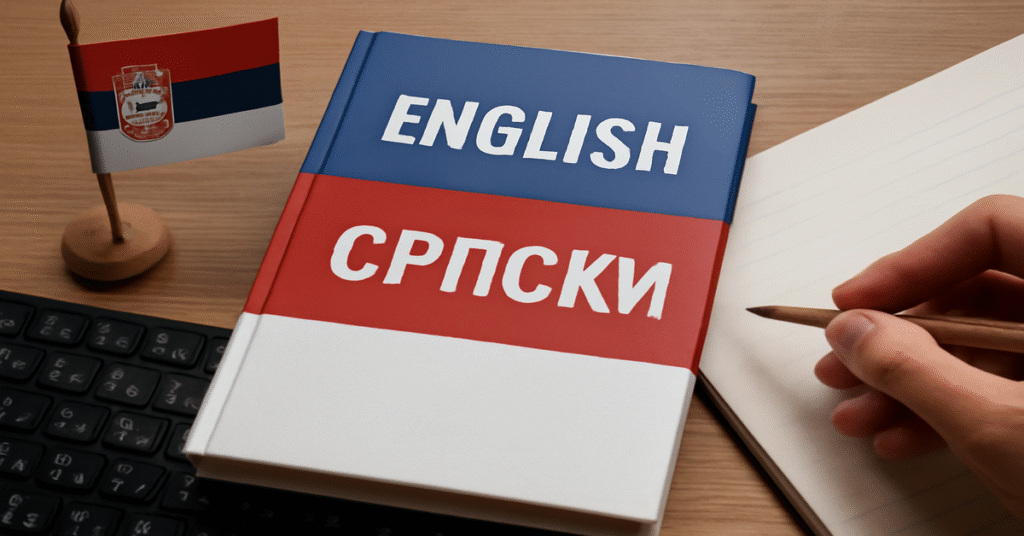Language is more than just a tool for communication; it is a bridge between cultures, an expression of identity, and a reflection of history. One such linguistic connection is the translation between English and Serbian, two languages that belong to different language families but are increasingly important in today’s globalized world.
Serbian is a South Slavic language spoken by millions in the Balkans and among diaspora communities worldwide. While English has become the dominant international lingua franca, Serbian remains central to the cultural, social, and political identity of the Serbian people. Whether you are a student, traveler, or professional, understanding how to translate English to Serbian opens up opportunities to engage more deeply with Serbian culture, literature, and history.
This article will delve into the key aspects of English to Serbian translation, including:
- The structure and grammar of Serbian
- Common linguistic challenges
- Tools and resources for learning Serbian
- Cultural differences in language use
Understanding Serbian: A Language of the Balkans
The Serbian Language Family
Serbian belongs to the South Slavic language group, which is a subset of the Indo-European language family. It shares common roots with other Slavic languages, including Croatian, Bosnian, Montenegrin, and Macedonian. Serbian is one of the official languages of Serbia, Bosnia and Herzegovina, and Montenegro, and it is widely spoken in Kosovo.
Despite the historical political differences between Serbia, Croatia, and Bosnia, Serbian, Croatian, and Bosnian are often considered mutually intelligible—meaning speakers of these languages can generally understand each other. However, there are distinct variations in vocabulary, pronunciation, and grammar that make each language unique.
Cyrillic and Latin Scripts
One of the most distinctive features of Serbian is its use of two scripts: the Cyrillic alphabet and the Latin alphabet.
- Cyrillic script is traditionally used in Serbia and is promoted by the state. It is also a strong symbol of Serbian identity.
- Latin script, however, is more commonly used in modern contexts, including in technology, advertising, and media.
Both alphabets are officially recognized, and Serbian speakers are fluent in using both, depending on the context. In translation, this dual-script issue often arises, as words written in one script must be accurately transcribed into the other.
Key Features of Serbian Grammar
Nouns and Gender
Serbian nouns are categorized into three genders:
- Masculine
- Feminine
- Neuter
Each gender has its own set of declensions, which determine how a noun will change depending on its case (subject, object, etc.). For example, the word “book” in Serbian is “knjiga”, which is feminine, and its declensions will follow a particular pattern for nominative, genitive, accusative, etc.
In English, nouns are generally gender-neutral, which can pose challenges for English speakers learning Serbian. The translation requires an understanding of gender agreement between nouns and adjectives, a feature that does not exist in the same form in English.
Verbs and Conjugation
Serbian verbs are conjugated based on person, number, tense, and aspect. There are two main verb aspects in Serbian:
- Perfective (completed action)
- Imperfective (ongoing or habitual action)
For example, the verb “to write” is “pisati” (imperfective), and “napišati” (perfective). In English, we might use auxiliary verbs to convey tense and aspect, but Serbian does this through the verb form itself.
Word Order and Syntax
Serbian is a highly inflected language, which means that the word order can be flexible compared to English. While English follows a strict Subject-Verb-Object (SVO) order, Serbian sentences can often be arranged with more flexibility because of its reliance on inflections.
For example:
- English: “I see the car.”
- Serbian: “Vidim auto.” (Subject-Verb-Object), but it could also be rearranged as “Auto vidim.” (Object-Verb-Subject)
This flexibility can present both a challenge and an opportunity in translation, as context plays a significant role in understanding sentence structure.
Cases in Serbian
Serbian uses seven grammatical cases, which determine the role of a noun or pronoun in a sentence. These cases are:
- Nominative (subject of the sentence)
- Genitive (possession or absence)
- Dative (indirect object)
- Accusative (direct object)
- Vocative (addressing someone)
- Instrumental (means or tools)
- Locative (location)
For example, the word “book” in Serbian is “knjiga”, but in different cases, it changes:
- Nominative: knjiga (the book)
- Genitive: knjige (of the book)
- Dative: knjizi (to the book)
- Accusative: knjigu (the book, object)
These case changes do not have an exact equivalent in English, where word order and prepositions generally indicate these relationships.
Common Challenges in English to Serbian Translation
Lexical Differences
Some English words have no direct equivalent in Serbian, especially in fields like technology, business, and modern culture. For instance, the word “smartphone” might be translated as “pametni telefon” (literally, “smart phone”), but this could vary depending on the context.
Translators need to be creative in selecting the most appropriate word that captures the meaning and cultural context. This becomes even more challenging when dealing with colloquial expressions or idioms.
Idiomatic Expressions
Idiomatic expressions in English often do not translate directly into Serbian due to cultural and linguistic differences. For example, the English expression “break a leg” (meaning “good luck”) would likely confuse a Serbian speaker if translated literally. In Serbian, the equivalent might be “srećno” or “puno sreće” (“good luck”).
These kinds of expressions require a translator to have a deep understanding of both cultures to convey the correct meaning and preserve the tone.
Tools for English to Serbian Translation
Google Translate
Google Translate is one of the most popular translation tools for English to Serbian. While it has made significant improvements over the years, it’s still a machine translation tool that may not always capture nuances like tone, idiomatic phrases, or grammatical gender.
Professional Translation Services
For official or important documents, professional translators are recommended. These services typically provide a more accurate translation that accounts for context, cultural references, and formality levels.
Language Learning Apps
Apps like Duolingo, Babbel, and Memrise offer useful resources for learning Serbian. While they are not focused on translation, they can help users understand the fundamentals of the language, improving their ability to interpret texts or engage in conversation.
The Role of Serbian in Global Communication
Serbian as a Minority Language
While Serbian is primarily spoken in the Balkans, it is also part of a broader linguistic community that includes Bosnian, Montenegrin, and Croatian. These languages are often referred to as the BCS languages (Bosnian-Croatian-Serbian), and they are mutually intelligible, meaning that speakers can understand each other despite using different names or variations of the language.
Understanding Serbian opens up communication not only in Serbia but also in regions such as Bosnia and Herzegovina, Montenegro, and parts of Croatia and Kosovo.
Serbian in International Diplomacy and Trade
Serbian plays a key role in regional diplomacy and international trade in Southeast Europe. As countries in the Balkans seek to integrate with the European Union, proficiency in Serbian becomes an increasingly valuable asset for diplomats, businesspeople, and humanitarian workers.
The Cultural Importance of Serbian
Literature and Media
Serbian is the language of rich literary traditions, with authors like Ivo Andrić (Nobel laureate) and Danilo Kiš contributing to world literature. Serbian cinema, music, and theater also remain vital parts of the cultural landscape.
For those interested in learning about Serbian history and culture, reading books, watching films, or consuming media in Serbian provides valuable insight into the country’s past, identity, and evolving modern society.
Conclusion
Translating from English to Serbian presents both challenges and opportunities, offering insights into the structural and cultural elements that shape the language. While English is the global lingua franca, Serbian remains an important part of the cultural fabric in Southeast Europe and beyond. Whether you’re a traveler, student, or professional, learning about Serbian language and translation equips you with the tools to navigate both the linguistic and cultural landscapes of the Balkans.
In today’s connected world, platforms for language learning, online translation tools, and professional services have made bridging the gap between English and Serbian more accessible. As the demand for global communication grows, mastering both languages enhances personal and professional engagement, opening doors to new experiences and deeper cultural understanding.
FAQs
Q1: How difficult is it to learn Serbian for English speakers?
A: Serbian is a relatively challenging language for English speakers due to its use of grammatical cases, gendered nouns, and two alphabets (Cyrillic and Latin). However, with dedication and the right resources, it is certainly learnable.
Q2: Can Google Translate accurately translate between English and Serbian?
A: Google Translate has improved significantly but may struggle with idiomatic expressions, cultural nuances, and complex grammar. It’s useful for basic translation, but professional services are recommended for official documents.
Q3: Why does Serbian use two alphabets?
A: Serbian uses both Cyrillic and Latin scripts as a result of historical and cultural influences. Both are officially used, with Cyrillic being more common in formal contexts.
Q4: Are Serbian, Croatian, and Bosnian the same language?
A: These languages are very similar and mutually intelligible. They are often grouped as BCS (Bosnian-Croatian-Serbian) but are considered distinct languages due to political, cultural, and regional differences.
Q5: How can I improve my Serbian?
A: To improve your Serbian, you can use apps like Duolingo, watch Serbian films and TV shows, practice with native speakers, and engage in regular reading and writing exercises.
Q6: How important is Serbian in the context of regional business and diplomacy?
A: Serbian is crucial for those engaging in business or diplomatic relations in the Balkans. It facilitates communication in countries like Serbia, Montenegro, Bosnia, and Kosovo, where Serbian is spoken.







